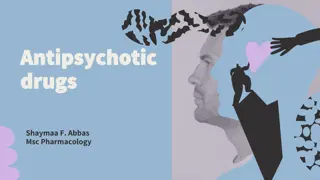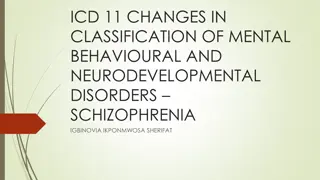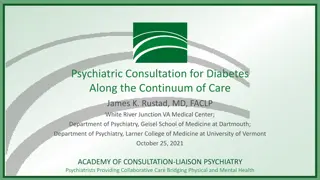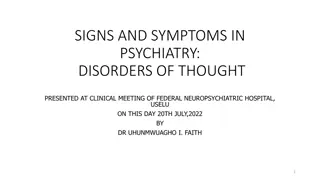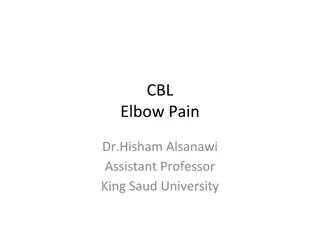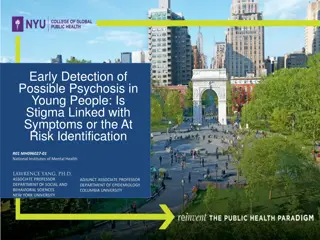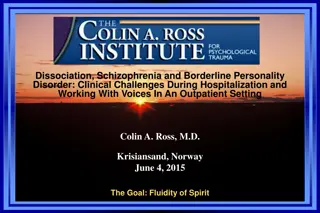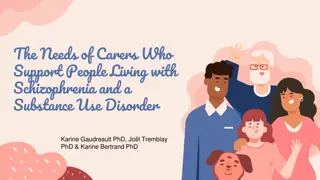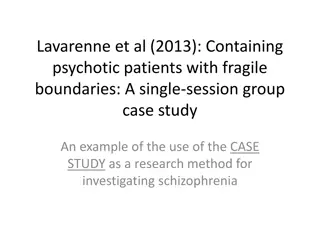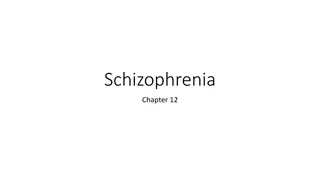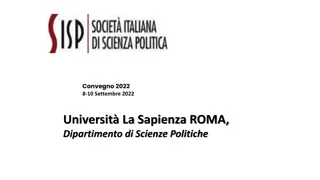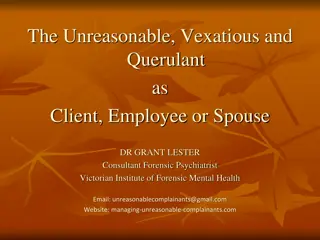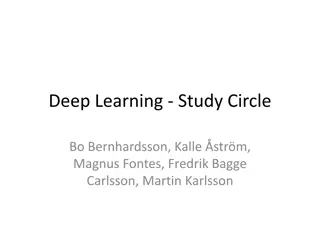Schizophrenia: Insights from Carlsson et al.'s 2000 Study
Carlsson et al.'s 2000 study on schizophrenia explores the dopamine hypothesis, highlighting the interplay of neurotransmitters like glutamate, serotonin, and GABA. They suggest future drug treatments for schizophrenia, emphasizing the need to consider neurotransmitter interactions beyond dopamine. The study discusses how excess dopamine may compensate for deficiencies in other neurotransmitters, and how dysfunctions in various neurotransmitter systems contribute to different symptoms of schizophrenia, such as positive and negative symptoms.
Download Presentation

Please find below an Image/Link to download the presentation.
The content on the website is provided AS IS for your information and personal use only. It may not be sold, licensed, or shared on other websites without obtaining consent from the author.If you encounter any issues during the download, it is possible that the publisher has removed the file from their server.
You are allowed to download the files provided on this website for personal or commercial use, subject to the condition that they are used lawfully. All files are the property of their respective owners.
The content on the website is provided AS IS for your information and personal use only. It may not be sold, licensed, or shared on other websites without obtaining consent from the author.
E N D
Presentation Transcript
LETS REVISE: EDEXCEL A LEVEL (AJW) One contemporary study of schizophrenia: Carlsson et al (2000)
AIM AIM To provide an up status of the dopamine hypothesis To raise awareness of the potential role of other neurotransmitters, e.g. glutamate, serotonin and GABA serotonin and GABA To present suggestions for future drug suggestions for future drug treatments treatments for the wide range of people with schizophrenia, many of whom are treatment resistant or who live with the extreme side effects (e.g. extra-pyramidal dysfunction) up- -to to- -date review date review of the current glutamate,
WHAT DOES WHAT DOES CARLSSON FUNCTION OF NEUROTRANSMITTERS IN FUNCTION OF NEUROTRANSMITTERS IN RELATION TO SCHIZOPHRENIA? RELATION TO SCHIZOPHRENIA? CARLSSON SAY ABOUT THE SAY ABOUT THE excess dopamine may be a by- product of dysfunction of another neurotransmitter excess in one area of the brain may be a way of compensating for a deficiency in another brain area
WHY DOES WHY DOES CARLSSON HYPERDOPAMINERGIA HYPERDOPAMINERGIA IS ONLY PART OF THE ANSWER? IS ONLY PART OF THE ANSWER? CARLSSON THINK THINK some people with schizophrenia show dopamine levels within the normal range dopaminergic dysfunction may only accounts for symptoms in a sub-group of patients some people with catatonic symptoms have hypodopaminergic activity
WHAT DOES HE SAY ABOUT OTHER WHAT DOES HE SAY ABOUT OTHER NEUROTRANSMITTERS? NEUROTRANSMITTERS? dopamine levels may be controlled by serotonin levels, if serotonin levels are too high, this could be linked to increased dopamine levels low levels of glutamate, may allow both serotonin and dopamine levels to become too high glutamatergic failure in the cerebral cortex may lead to negative symptoms the basal ganglia could be responsible for the positive symptoms
GLUTAMATE AS A DOPAMINE ACCELERATOR ACCELERATOR In the meso glutamate acts as an accelerator leading to increased dopamine increased dopamine activity meso- -cortical cortical pathway accelerator if this goes wrong if this goes wrong and glutamate levels fall too low glutamate levels fall too low dopamine levels drop dopamine levels drop leading to negative symptoms negative symptoms
GLUTAMATE AS A DOPAMINE BRAKE in the meso glutamate acts as a brake signalling to GABA neurons to inhibit dopamine production meso- -limbic limbic pathways brake if the brake does not work if the brake does not work glutamate levels are too low leading to low levels of GABA low levels of GABA thus high levels of dopamine high levels of dopamine resulting in positive symptoms
WHAT DOES WHAT DOES CARLSSON FUTURE DRUG TREATMENTS FOR FUTURE DRUG TREATMENTS FOR SCHIZOPHRENIA? SCHIZOPHRENIA? CARLSSON SAY REGARDING SAY REGARDING serotonin antagonists to bring down serotonin levels glutamate agonists - to increase glutamate levels differing symptoms may be the result of differing neurochemical aetiologies requiring differing treatments
EVALUATING EVALUATING CARLSSON CARLSSON ET AL (2000) ET AL (2000) Studies of PCP: Angel Dust (this drug reduces glutamate) Studies of PCP: Angel Dust (this drug reduces glutamate) One strength of Carlsson s theory that dopamine levels may be elevated due to low levels of glutamate is that it is supported by experiments with the drug PCP or angel dust . These studies demonstrate that PCP, an antagonist on the NMDA, glutamate receptor can induce schizophrenic-like symptoms. This is important because it shows that PCP (a drug which decreases glutamate levels) has very similar effects to drugs such as amphetamine which increase dopamine levels, suggesting that schizophrenia may be linked to hypoglutamatergic activity. (well-developed chain of reason)
COMPETING ARGUMENT This said, some psychologists argue that PCP research is contradictory and sometimes PCP actually enhances rather than reduces the release of glutamate this ambiguity casts doubt on hypoglutamatergia as a cause of schizophrenia.
STUDIES WITH KETAMINE (THIS DRUG ALSO STUDIES WITH KETAMINE (THIS DRUG ALSO REDUCES GLUTAMATE REDUCES GLUTAMATE ) A further strength is that SPECT imaging studies show that another glutamate antagonist, ketamine, enhances amphetamine-induced dopamine release in humans. These findings have also been replicated with rats under more controlled conditions demonstrating that the conclusions regarding the role of glutamate in increasing dopamine levels are both reliable and internally valid.
COMPETING ARGUMENT Animal research criticism evolutionary continuity Role of environmental and cultural factors is overlooked EBH, Luhrmann The part to be played by psychological therapies that do not use drugs and lock people into a life of fluctuating dopamine levels, Murray s comments about his career
POST MORTEM STUDIES POST MORTEM STUDIES Suggest hyperserotonergic function in people with paranoid schizophrenia Applications to treatment: clozapine Les tardive dyskinesia so more ethical and likely greater compliance
CARLSSON CARLSSON AND AND CARLSSON CARLSSON (1989) (1989) A final strength of Carlsson s theory, regarding the role of glutamate in schizophrenia, is that his ideas are supported by his experiments with mice Mice are given drugs to reduce motor activity Their motor activity can be restarted by blocking glutamate receptors with the drug MK801 Thus reducing glutamate and increasing serotonin and dopamine in the nucleus accumbens He also observed however, that if you keep on giving the mice MK801 (sustained low levels of glutamate) you get highly abnormal behaviour (similar to psychotic behaviour) This is important as it suggests that anything that interferes with glutamate may be a causal factor in schizophrenia and his also offers another possible treatment regarding glutamate agonists.
MOUNTING STRENGTHS BUT WHAT ABOUT THE WEAKNESSES? Animal experiments Post Mortem studies Brain imaging What weaknesses can you think of, now make these weaknesses specific to our understanding of the role of glutamate and our understanding of schizophrenia?
FACTORS THAT ARE OVERLOOKED BY CARLSSON? The papers focuses on biochemisty without considering environmental factors which could impact levels of different neurotransmitters Could diet, lifestyle, sleep, stress impact glutamate and therefore be implicated in the treatment rather than looking to new classes of drugs which may also have their own debilitating side effects?
THE NUANCED KILLER CONCLUSION think about Harry and Kate in Angel Baby Nathanial in the Soloist their friends and family members Brian, the homeless man in London living a desperate life on the streets of London Does this give you some perspective? How do you feel about Carlsson s contribution The conclusion should not be overly emotional dissect the issues and what we have learnt appeals to the human angle and socio-cultural, political and economic factors which drive research and publication bias Think about Murray?
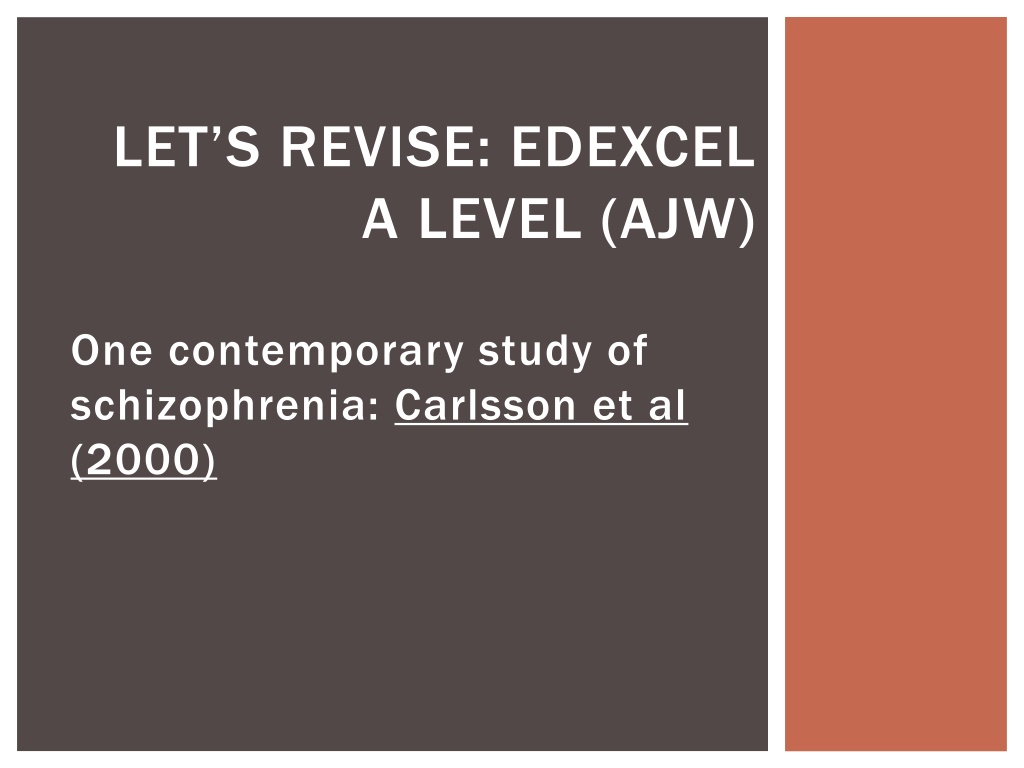
 undefined
undefined



